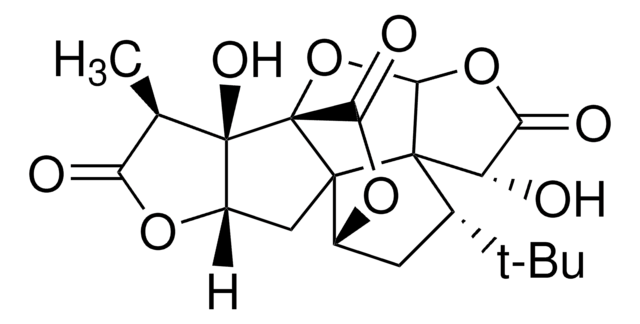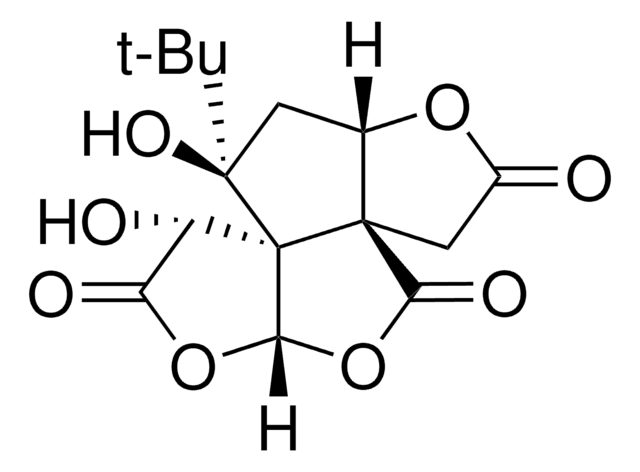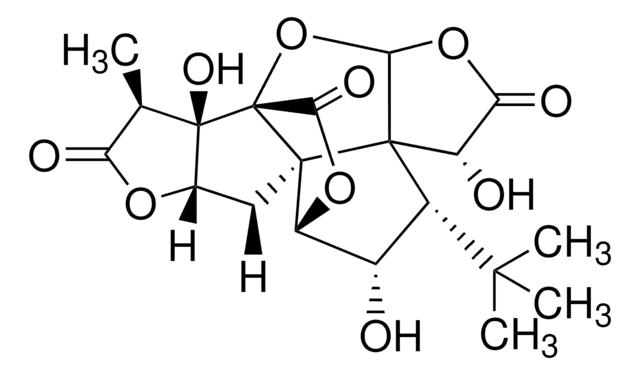B9031
(−)-Bilobalide from Ginkgo biloba leaves
≥93% (HPLC)
Synonym(s):
Bilobalide
Sign Into View Organizational & Contract Pricing
All Photos(4)
About This Item
Empirical Formula (Hill Notation):
C15H18O8
CAS Number:
Molecular Weight:
326.30
MDL number:
UNSPSC Code:
85151701
PubChem Substance ID:
NACRES:
NA.28
Recommended Products
biological source
plant leaves (Ginkgo biloba)
Quality Level
Assay
≥93% (HPLC)
form
powder
technique(s)
HPLC: suitable
color
white
storage temp.
−20°C
SMILES string
CC(C)(C)[C@]1(O)CC2OC(=O)C[C@@]23C(=O)OC4OC(=O)[C@H](O)[C@]134
InChI
1S/C15H18O8/c1-12(2,3)14(20)4-6-13(5-7(16)21-6)10(19)23-11-15(13,14)8(17)9(18)22-11/h6,8,11,17,20H,4-5H2,1-3H3/t6-,8-,11-,13-,14+,15+/m0/s1
InChI key
MOLPUWBMSBJXER-YDGSQGCISA-N
General description
Bilobalide is a biologically active terpenic trilactone (terpenoid) extracted from Ginkgo biloba. It is synthesized from geranylgeranyl pyrophosphate (GGPP).
Application
(-)-Bilobalide from Ginkgo biloba leaves has been used as a reference substance to study the antimicrobial activity of different fractions of G.biloba leaves against a number of Gram-positive and negative bacteria and yeasts.
Biochem/physiol Actions
Bilobalide is an inducer of cytochrome P450 enzymes CYP3A1 and CYP1A2. It exhibits neuroprotective, anti-inflammatory, anti-oxidative and anti-apoptotic properties. Bilobalide, a γ-aminobutyric acid (GABA) AA-rho, 5-hydroxytryptamine type 3 (5-HT(3)) receptor antagonist, may be used to study the function of these receptors in the brain processes such as cognition and memory. It serves as a specific platelet-activating factor receptor antagonist, which helps in the treatment of cardiovascular (Alzheimer′s disease) and cerebrovascular diseases.
Bioactive terpenoid found in Ginkgo biloba.
Storage Class Code
11 - Combustible Solids
WGK
WGK 3
Flash Point(F)
Not applicable
Flash Point(C)
Not applicable
Personal Protective Equipment
dust mask type N95 (US), Eyeshields, Gloves
Choose from one of the most recent versions:
Already Own This Product?
Find documentation for the products that you have recently purchased in the Document Library.
Customers Also Viewed
Protective and therapeutic role of Bilobalide in cuprizone-induced demyelination
Sui RX, et al.
International Immunopharmacology, 66, 69-81 (2019)
Antimicrobial investigation of semipurified fractions of Ginkgo biloba leaves
Mazzanti G, et al.
Journal of Ethnopharmacology, 71(1-2), 83-88 (2000)
Chun Shi et al.
Apoptosis : an international journal on programmed cell death, 15(6), 715-727 (2010-03-25)
Bilobalide, a sesquiterpene trilactone constituent of Ginkgo biloba leaf extracts, has been proposed to exert protective and trophic effects on neurons. However, mechanisms underlying the protective effects of bilobalide remain unclear. Using human SH-SY5Y neuroblastoma cells and primary hippocampal neurons
Soo Lim et al.
PloS one, 6(6), e20301-e20301 (2011-06-10)
EGb761, a standardized Ginkgo biloba extract, has antioxidant and antiplatelet aggregation and thus might protect against atherosclerosis. However, molecular and functional properties of EGb761 and its major subcomponents have not been well characterized. We investigated the effect of EGb761 and
Aik Jiang Lau et al.
Drug metabolism and disposition: the biological fate of chemicals, 40(1), 178-186 (2011-10-25)
Bilobalide is a naturally occurring sesquiterpene trilactone with therapeutic potential in the management of ischemia and neurodegenerative diseases such as Alzheimer's disease. In the present study, we investigated the effect of bilobalide on the activity of rat constitutive androstane receptor
Our team of scientists has experience in all areas of research including Life Science, Material Science, Chemical Synthesis, Chromatography, Analytical and many others.
Contact Technical Service








